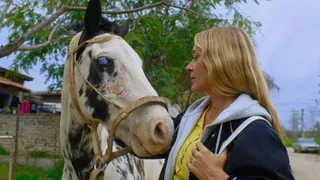
October 9, 2023
Review: 'The Matthew Shepard Story: An American Hate Crime' Sheds Light and Legacy on the 25-Year-Old Case
Matthew Creith READ TIME: 4 MIN.
"We were just asking to not be murdered. It is the most modest of requests."
In 1998, a University of Wyoming student accidentally encountered a puzzling situation: In a remote part of the state near Laramie, they thought they had discovered what appeared to be a scarecrow. Given that it was October and the spooky season was just around the corner, that's an understandable assumption. However, upon closer inspection, the student realized it was the nearly lifeless body of a fellow student hanging on for dear life.
That fellow student was 21-year-old Matthew Shepard, left to die, clearly beaten and bloody from head to toe. Rushed to Poudre Valley Hospital in Fort Collins, Colorado, young Matthew held on in the ICU as long as he could as his parents, friends, and the nation waited with bated breath. Five days later, Matthew succumbed to his injuries and passed away.
The Matthew Shepard murder case has been discussed, examined, and fictionalized on television many times in the 25 years since it occurred. Now, ID is unveiling "The Matthew Shepard Story: An American Hate Crime," a two-hour documentary that details the events of the case, Matthew's legacy, and the continuing fight for LGBTQ+ rights in America.
The United States was profoundly impacted, politically and socially, by Shepard's murder. Infighting broke out from both the left and right sides of the aisle, and the murder gave rise to a media firestorm that included coverage of the infamous Westboro Baptist Church protesting funerals by making a mockery of what was once considered a solemn occasion. But why did a kind, gentle, nice-looking kid from a college town in conservative Wyoming find himself in a situation where he was brutally attacked and ultimately killed by two perpetrators?
Matthew Shepard was gay. The perpetrators, Aaron McKinney and Russell Henderson, met Matthew Shepard at the Fireside Lounge in Laramie. Matthew left with the two men and, shortly thereafter, was tortured and left to die because, they claimed, Matthew hit on them.
The idea of going to prison at the time for a hate crime, especially involving a gay person, was completely unheard of. Both McKinney and Henderson ended up with life sentences in prison, and officers have remarked that neither was remorseful for their actions. It wasn't until 2009 that President Barack Obama signed the Matthew Shepard and James Byrd, Jr. Hate Crimes Prevention Act into law after years of stalling on the congressional chamber floor.
Interviews with out celebrities like Rosie O'Donnell, Adam Lambert, and Andrew Rannells give context to Matthew's effect on the LGBTQ+ community and American society at large. O'Donnell explains it best when she states, "My soul ached at humans' ability to be cruel to another." Rannells reads Matthew's journal entries aloud to give humanity to the slain young man's words. The celebrities also discuss their own experiences as young gay people trying to find balance in a conservative environment.
Further interviews with a sheriff's department first responder who was first on the scene, Matthew's parents and friends, bartenders, journalists, and others help to shed light on Matthew's life and what this case meant to the nation. Many of these interviews were conducted in 2011 and rehashed in this documentary. Much of what is covered is not new information. However, this documentary gives essential background information on why the crime was committed, and what the aftermath was for gay youth and hate crime legislation. The doc is thorough, politically charged, and compares some events from the 1990s to today's push to shut down drag shows and pass anti-LGBTQ+ legislation in states like Florida and Texas.
This documentary excels when it is a comprehensive look at the murder, the victim, the media reaction, and Matthew Shepard's legacy. Context is given regarding Wyoming's small population, conservative values, and simply setting the scene for viewers unfamiliar with the case. Although this was a time when middle America was learning more about gay people through pop culture events like "Will and Grace" and Ellen DeGeneres' coming out journey, there was still a great deal of bigotry on the surface towards those labeled "different." This wasn't a Wyoming problem; it became a concern for the safety of gay people everywhere.
In death, Matthew Shepard's legacy is similar to that of Harvey Milk and those who were there at Stonewall; it helped propel the country down the road of equal rights legislation. But the documentary is very clear that though significant progress took place for the rights of gay people, recent events and political shifts have proved that those rights could be on the chopping block yet again. Trans people are the current targets, and the Don't Say Gay law in Florida specifically bans discussing LGBTQ+ issues in the classroom.
The fight is not over.
"The Matthew ShepardStory: An American Hate Crime" premieres Monday, October 9, from 9-11PM ET/PT on ID.







